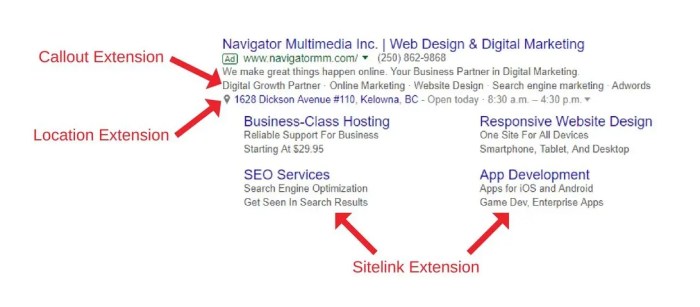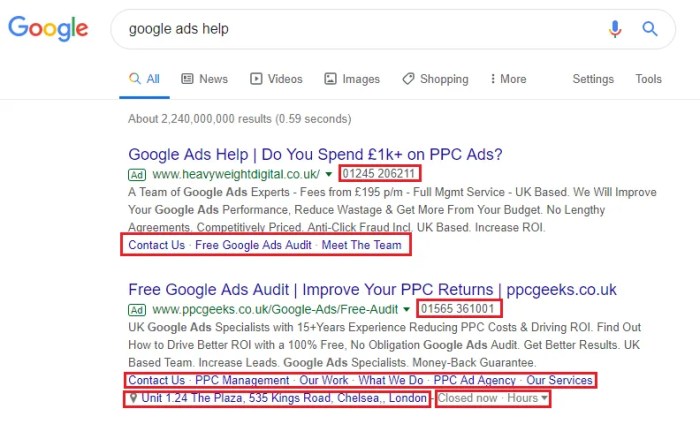Using Google Ads Extensions takes center stage in the world of online advertising, offering a plethora of opportunities to enhance your campaign strategies. Get ready to dive into the realm of ad extensions and revolutionize your Google Ads game!
Introduction to Google Ads Extensions
Google Ads Extensions are additional pieces of information that can be added to your Google Ads campaigns to provide more value and relevant information to potential customers. These extensions help in enhancing the visibility and performance of your ads by giving users more reasons to click on them.
Importance of Using Extensions in Google Ads
Using extensions in Google Ads is crucial as they can make your ads more informative and engaging for users. They allow you to provide additional details about your business, products, or services, increasing the chances of attracting potential customers. Extensions also help in improving ad rank and increasing click-through rates, ultimately leading to better campaign performance.
How Extensions Enhance the Performance of Google Ads Campaigns
- Extensions provide valuable information: By including extensions like callouts, sitelinks, and structured snippets, you can highlight key selling points and unique features of your business.
- Extensions increase ad visibility: With extensions, your ads can take up more space on the search results page, making them more prominent and eye-catching to users.
- Extensions improve ad relevance: By customizing extensions to match the search intent of users, you can deliver more targeted and relevant ads, leading to higher quality clicks.
- Extensions boost click-through rates: Including extensions that encourage user interaction, such as call extensions or location extensions, can drive more qualified leads to your website.
Types of Google Ads Extensions
Google Ads offers various types of extensions to help advertisers enhance their ad visibility and performance. By utilizing these extensions strategically, advertisers can provide more information to potential customers and improve the chances of getting clicks. Let’s explore some of the key types of Google Ads extensions and how they can be beneficial.
Sitelink Extensions
Sitelink extensions allow advertisers to include additional links to specific pages on their website, giving users more options to explore. These links can lead to relevant landing pages, product pages, or other sections of the website. By using sitelink extensions, advertisers can direct users to specific areas of interest and increase the likelihood of conversions.
Callout Extensions
Callout extensions enable advertisers to highlight key selling points or offers within the ad copy. These short snippets of text can be used to emphasize free shipping, 24/7 customer support, or any other unique value propositions. By including callout extensions, advertisers can make their ads more compelling and attract the attention of potential customers.
Location Extensions
Location extensions are beneficial for businesses with physical locations as they display the address, phone number, and a map marker alongside the ad. This type of extension helps users find a store or office easily and can drive foot traffic to local businesses. By using location extensions, advertisers can increase in-store visits and connect with nearby customers.
Call Extensions
Call extensions allow advertisers to include a phone number in their ads, making it easy for users to contact the business directly. This is particularly useful for service-based businesses that rely on phone inquiries or appointments. By adding call extensions, advertisers can generate more leads and conversions from users who prefer to call rather than click through to a website.
Review Extensions
Review extensions showcase positive third-party reviews or ratings within the ad, adding credibility and trustworthiness to the business. By featuring testimonials or ratings from reputable sources, advertisers can build confidence with potential customers and increase click-through rates. Review extensions are especially useful for businesses looking to establish authority in their industry.
Structured Snippet Extensions, Using Google Ads Extensions
Structured snippet extensions allow advertisers to highlight specific aspects of their products or services, such as product categories, brands, or amenities. This extension provides additional information to users and helps them make informed decisions before clicking on the ad. By using structured snippet extensions, advertisers can showcase the variety and quality of offerings available.
Price Extensions
Price extensions display pricing information for specific products or services directly within the ad. This type of extension is useful for businesses that offer competitive pricing or promotions, as it helps users evaluate costs upfront. By including price extensions, advertisers can attract price-conscious customers and drive more qualified leads to their website.
App Extensions
App extensions promote mobile apps by including a direct link to download the app from the App Store or Google Play. This extension is beneficial for businesses looking to increase app installations and engagement among mobile users. By utilizing app extensions, advertisers can drive app downloads and encourage users to interact with their brand on mobile devices.
Setting Up Google Ads Extensions: Using Google Ads Extensions

When it comes to setting up Google Ads extensions, you want to make sure you’re maximizing the potential of your ads by providing additional information to potential customers. Here’s how you can set up extensions in your Google Ads account:
Linking Extensions to Your Campaigns
To start, log in to your Google Ads account and navigate to the “Ads & Extensions” tab. From there, click on “Extensions” and then the blue plus button to create a new extension. Choose the type of extension you want to create and fill in the necessary information. Make sure to link the extension to the relevant campaigns for maximum impact.
Best Practices for Configuring Extensions
– Ensure that your extensions are relevant to the ad and provide valuable information to users.
– Use all available extension types to give users a variety of ways to engage with your ad.
– Monitor the performance of your extensions regularly and make adjustments as needed to improve results.
– Test different extension variations to see which ones work best for your specific goals.
Monitoring and Optimizing Extensions
– Keep track of key metrics such as click-through rate, conversion rate, and cost per conversion to measure the effectiveness of your extensions.
– Use Google Ads reporting tools to analyze the performance of your extensions and identify areas for improvement.
– A/B test different extension combinations to see which ones drive the best results.
– Continuously optimize your extensions based on performance data to ensure you’re getting the most out of your ad campaigns.
Benefits of Using Google Ads Extensions

Incorporating extensions in Google Ads campaigns can provide numerous benefits to advertisers. These extensions can enhance the visibility and performance of ads, ultimately helping advertisers achieve their campaign goals more effectively.
Improved Ad Performance
- Extensions increase the ad’s overall size and make it more prominent on the search results page, leading to higher visibility and click-through rates.
- Additional information provided through extensions, such as location, phone number, or links, can help users make informed decisions and increase the chances of conversions.
- Extensions can also improve ad relevance and quality score, which can result in lower costs per click and better ad positioning.
Enhanced User Experience
- Extensions make it easier for users to find relevant information quickly, such as contact details, product offerings, or promotions, leading to a more seamless user experience.
- By providing valuable information upfront, extensions can attract more qualified leads and increase the likelihood of conversions.
Increased Click-Through Rates
- Ads with extensions typically have higher click-through rates compared to standard text ads, as they offer more information and options for users to engage with the ad.
- Extensions can make ads more compelling and enticing, encouraging users to click and explore further.












